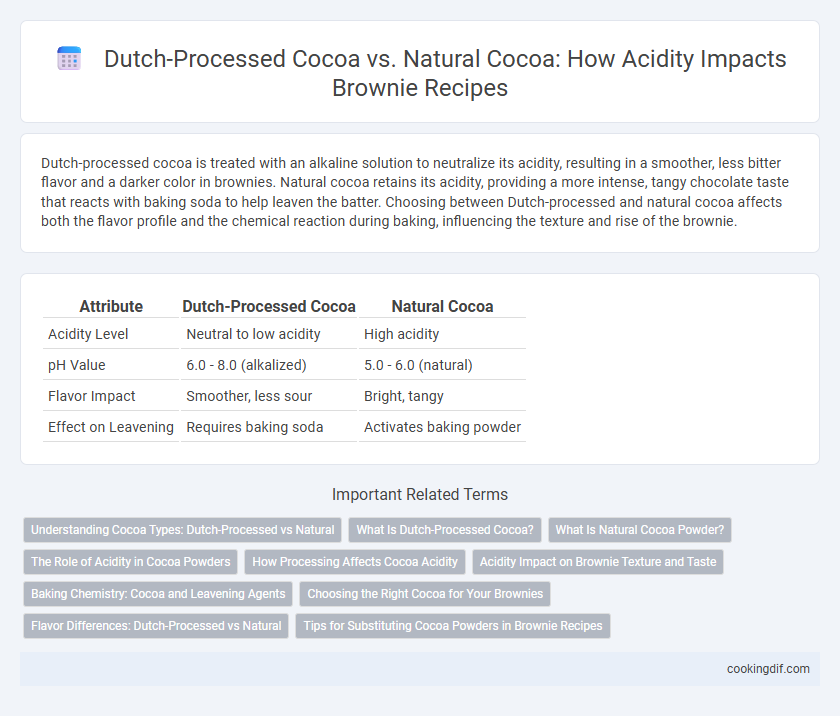Dutch-processed cocoa is treated with an alkaline solution to neutralize its acidity, resulting in a smoother, less bitter flavor and a darker color in brownies. Natural cocoa retains its acidity, providing a more intense, tangy chocolate taste that reacts with baking soda to help leaven the batter. Choosing between Dutch-processed and natural cocoa affects both the flavor profile and the chemical reaction during baking, influencing the texture and rise of the brownie.
Table of Comparison
| Attribute | Dutch-Processed Cocoa | Natural Cocoa |
|---|---|---|
| Acidity Level | Neutral to low acidity | High acidity |
| pH Value | 6.0 - 8.0 (alkalized) | 5.0 - 6.0 (natural) |
| Flavor Impact | Smoother, less sour | Bright, tangy |
| Effect on Leavening | Requires baking soda | Activates baking powder |
Understanding Cocoa Types: Dutch-Processed vs Natural
Dutch-processed cocoa undergoes an alkalizing treatment that reduces its acidity and darkens its color, resulting in a smoother, less bitter flavor perfect for brownies requiring a milder chocolate taste. Natural cocoa retains its natural acidity and has a more intense, fruity, and sharp flavor profile, which reacts with baking soda to create a lighter texture and lift in baked goods. Understanding these differences helps bakers select the right cocoa type to achieve the desired brownie taste, texture, and appearance.
What Is Dutch-Processed Cocoa?
Dutch-processed cocoa, also known as alkalized cocoa, undergoes treatment with an alkalizing agent to neutralize its natural acidity, resulting in a smoother, less bitter flavor compared to natural cocoa. This process increases the pH to around 7, making it ideal for recipes like brownies where a mild, mellow chocolate taste is preferred and baking soda is used as a leavening agent. Understanding the difference between Dutch-processed and natural cocoa is crucial, as Dutch-processed cocoa's neutral pH affects the chemical reactions and texture in baking.
What Is Natural Cocoa Powder?
Natural cocoa powder is made from roasted cocoa beans that are lightly processed, retaining their natural acidity and fruity flavor profile. It typically has a pH level between 5 and 6, contributing to a tangy taste that reacts with baking soda to help brownies rise. Unlike Dutch-processed cocoa, natural cocoa powder is not neutralized with alkali, making it essential to balance recipes accordingly to ensure the desired texture and flavor in baked goods.
The Role of Acidity in Cocoa Powders
Dutch-processed cocoa is treated with an alkalizing agent, which neutralizes its natural acidity, resulting in a milder, smoother flavor and darker color ideal for brownies with less tang. Natural cocoa retains its acidic properties, contributing bright, complex flavors that react with baking soda to help leaven brownies. The role of acidity in cocoa powders directly affects brownie texture and taste, making Dutch-processed cocoa preferable for denser, richer Brownies and natural cocoa better for lighter, more aerated results.
How Processing Affects Cocoa Acidity
Dutch-processed cocoa undergoes an alkalization process that neutralizes its natural acidity, resulting in a smoother, less bitter flavor profile ideal for brownies. Natural cocoa retains a higher acidity level, which reacts with baking soda to provide leavening and a tangy taste. The difference in acidity due to processing directly influences the texture and flavor balance of brownie recipes.
Acidity Impact on Brownie Texture and Taste
Dutch-processed cocoa has a neutral pH due to its alkalization, which reduces acidity and results in a smoother, milder flavor that creates a denser and fudgier brownie texture. Natural cocoa is more acidic, contributing a sharper, tangier taste and a lighter, cakier crumb in brownies. The acidity in natural cocoa activates baking soda, promoting leavening and altering the brownie's rise and mouthfeel compared to the neutral Dutch-processed alternative.
Baking Chemistry: Cocoa and Leavening Agents
Dutch-processed cocoa is treated with an alkaline solution to neutralize its acidity, resulting in a pH around 7, which makes it less reactive with baking soda. In contrast, natural cocoa retains its acidic properties with a pH between 5 and 6, allowing it to react with baking soda to release carbon dioxide for leavening. Understanding the pH difference between Dutch-processed and natural cocoa is essential for balancing leavening agents in brownie recipes to achieve the desired texture and rise.
Choosing the Right Cocoa for Your Brownies
Dutch-processed cocoa is treated with an alkalizing agent to reduce acidity, resulting in a smoother, less bitter flavor perfect for brownies requiring a mellow chocolate taste and even color. Natural cocoa retains its natural acidity, which reacts with baking soda to help leaven and create a tender crumb, ideal for recipes that call for a light, tangy chocolate flavor and more pronounced rise. Selecting the right cocoa depends on your desired brownie texture and flavor profile, with Dutch-processed suited for rich, dense brownies and natural cocoa enhancing lift and moistness through its acidic properties.
Flavor Differences: Dutch-Processed vs Natural
Dutch-processed cocoa undergoes alkalization, resulting in a smoother, milder flavor with reduced acidity compared to natural cocoa, which retains a bright, more pronounced bitter and fruity taste due to its higher acidity. The lower acidity in Dutch-processed cocoa produces a richer, less sharp chocolate flavor ideal for recipes requiring baking powder. Natural cocoa's acidic profile enhances tangy notes and intensifies the cocoa's complexity, preferred in recipes using baking soda to balance pH levels.
Tips for Substituting Cocoa Powders in Brownie Recipes
Dutch-processed cocoa has a neutral pH due to alkalizing treatment, resulting in less acidity compared to natural cocoa, which maintains its natural acidic properties. When substituting Dutch-processed cocoa in brownie recipes originally calling for natural cocoa, it is essential to replace baking soda with baking powder or adjust leavening agents to achieve the desired rise and texture. Balancing acidity affects both flavor and texture, so carefully modify leavening ingredients to maintain optimal brownie density and moistness.
Dutch-processed cocoa vs natural cocoa for acidity Infographic

 cookingdif.com
cookingdif.com